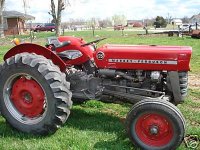Was wondering if anyone could tell me if I could haul a Massey Ferguson 135 on a Uhaul auto transport trailer. I am unsure of the year of the tractor and am posting a pic in case it helps.
The weight of the tractor should not be a problem, I am just worried about the width. I can't find the trailers minimum width, only the maximum.
This is the info on the trailer:
What do you all think?
The weight of the tractor should not be a problem, I am just worried about the width. I can't find the trailers minimum width, only the maximum.
This is the info on the trailer:
Max load: 4,000 lbs
The vehicle being towed:
Must have a maximum outside-to-outside tire width of 75"
Must have a maximum wheelbase (distance from front axle to rear axle, usually posted on the driver's side door jamb) of 133 inches.
What do you all think?
